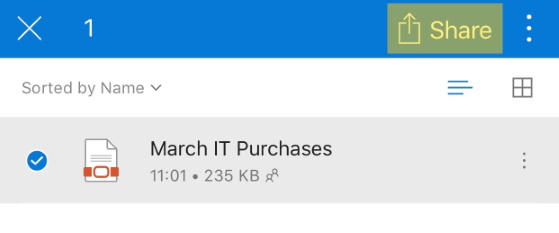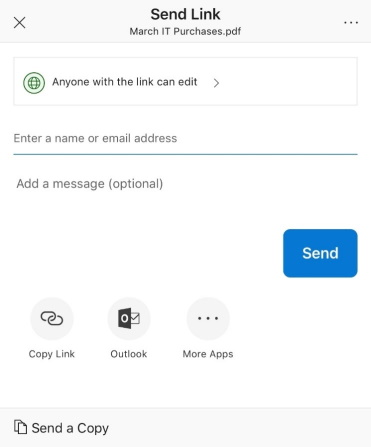Sharing files or folders with OneDrive (mobile user)
OneDrive is essentially free online storage that comes with your Microsoft account. It can be considered as your own personal drive for saving documents, but you can use OneDrive to share files, or folders, with others too. Save your files to OneDrive and you'll be able to get to them from any PC, tablet, or phone. OneDrive for mobile devices is available from the App/Play Store for iOS and Android.
This article shows how to share files or folders with OneDrive on your mobile device. For desktop users, see KB0011360, Sharing files or folders with OneDrive (desktop users).
Sharing files or folders with OneDrive
Files and folders stored in OneDrive are private, until you decide to share them. You can share documents with internal colleagues and external parties.
To do this, proceed as follows:
- Open the OneDrive app on your mobile device and log in to your Office 365 account.
- From within OneDrive, select the file/folder that you would like to share by pressing and holding.
- Optional: To select more than one file/folder, tap each additional item.
- On the menu bar at the top of the screen, press Share.

Note:
The Share function may alternatively be accessed by clicking on the three dots (ellipsis) that appear to the right of the file name.
The Share dialogue box opens, on the Send Link page.

From the Send Link page in the Share dialogue box, you can invite people via an email, or press Copy Link to create a link to view or download the file for manual sharing.
Send Link
Send Link is the recommended way to share a document.
- Enter the name(s) or email address(es) of the recipients.
- Optional: Press the dropdown list to change the type of link.

- Anyone with the link - Gives access to anyone who receives this link. This includes direct recipients, or other users who may have been forwarded the link. This may include people outside of your organisation.
- People in (your organisation) with the link - Gives access to anyone who receives this link, as long as they are part of your organisation. This includes direct recipients, or other users who may have been forwarded the link.
- People with existing access - Can be used to send links to people who already have access to the document or folder. This option does not make changes to existing permissions.
- Specific people - Gives access only to the people you specify, although other people may already have access. If people forward the sharing invitation, only people who already have access to the item will be able to use the link.
- Allow editing - Is turned on by default. Un-tick it if you want to give view-only permission to recipients.
- Type a short introductory message if required.
- Press Send.
The selected individuals now have access to your shared document.
Note:
If you just want to send a copy of the file instead of sharing, use Send a Copy instead. (Available at the bottom of the Send Link page in the Share dialogue box).
Copy Link
Important:
Be careful. Copy Link can make the file available to anyone, including other users who may have been forwarded the link.
- Optional: Press the dropdown list to change the type of link. The same options are available as described previously in these instructions under Send Link.
- Press Copy Link to create a link to view or download the file for you to share manually.
- Paste the copied link into an email, text message, instant message, or any other medium, and your recipient will instantly have access to the file.
Managing access
In time, you may wish to amend access to your shared files/folders. This can be completed within the same Share dialogue box used to initially share the item.
- From the Share menu, press the three dots (ellipsis) at the top right of the screen, then click Manage Access.

- From the Manage Access menu, press the black X on the right-hand side of the link you would like to remove.

The link is deleted.
Important:
Deleting a link will prevent users from accessing the item you are modifying.